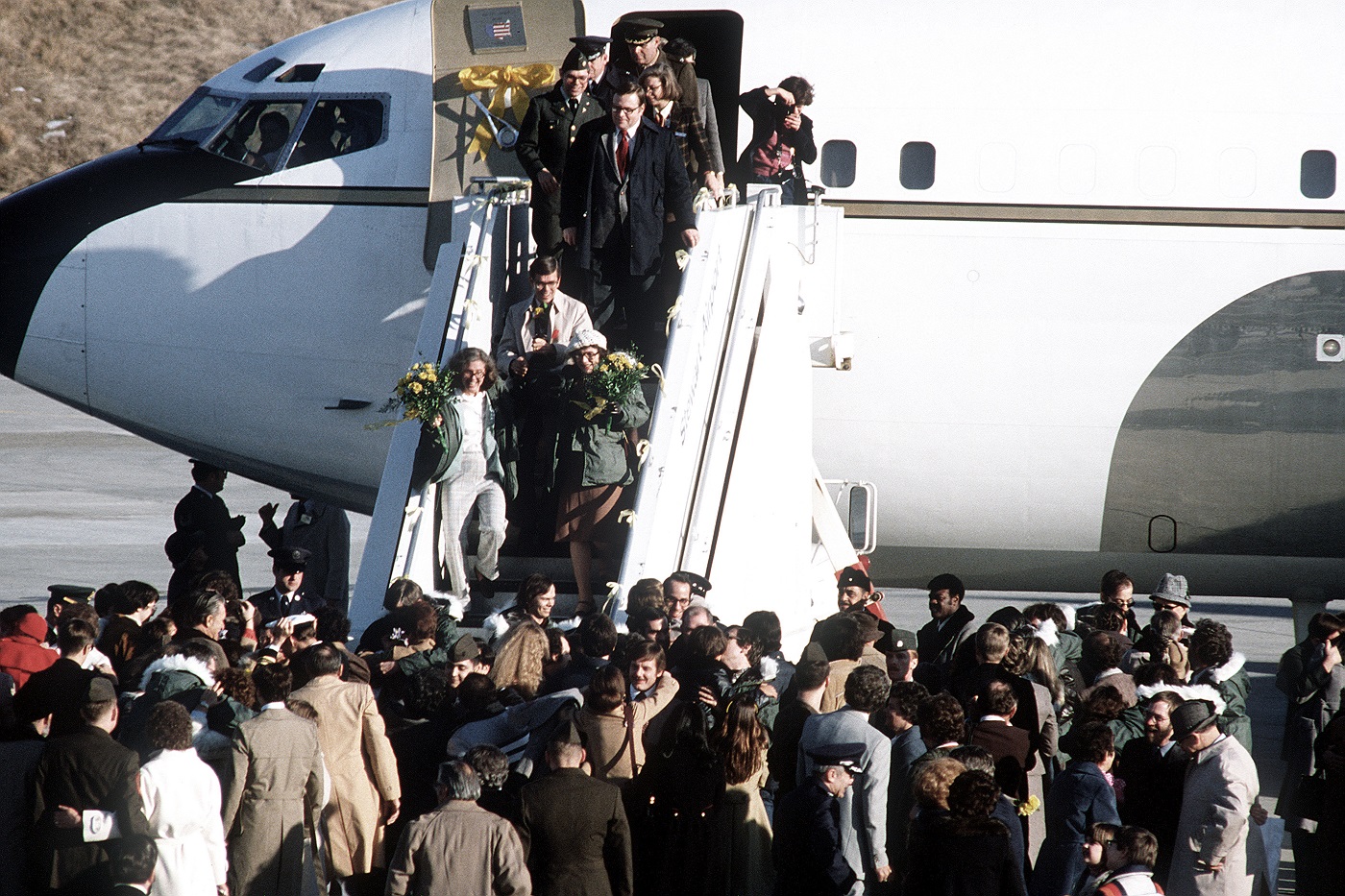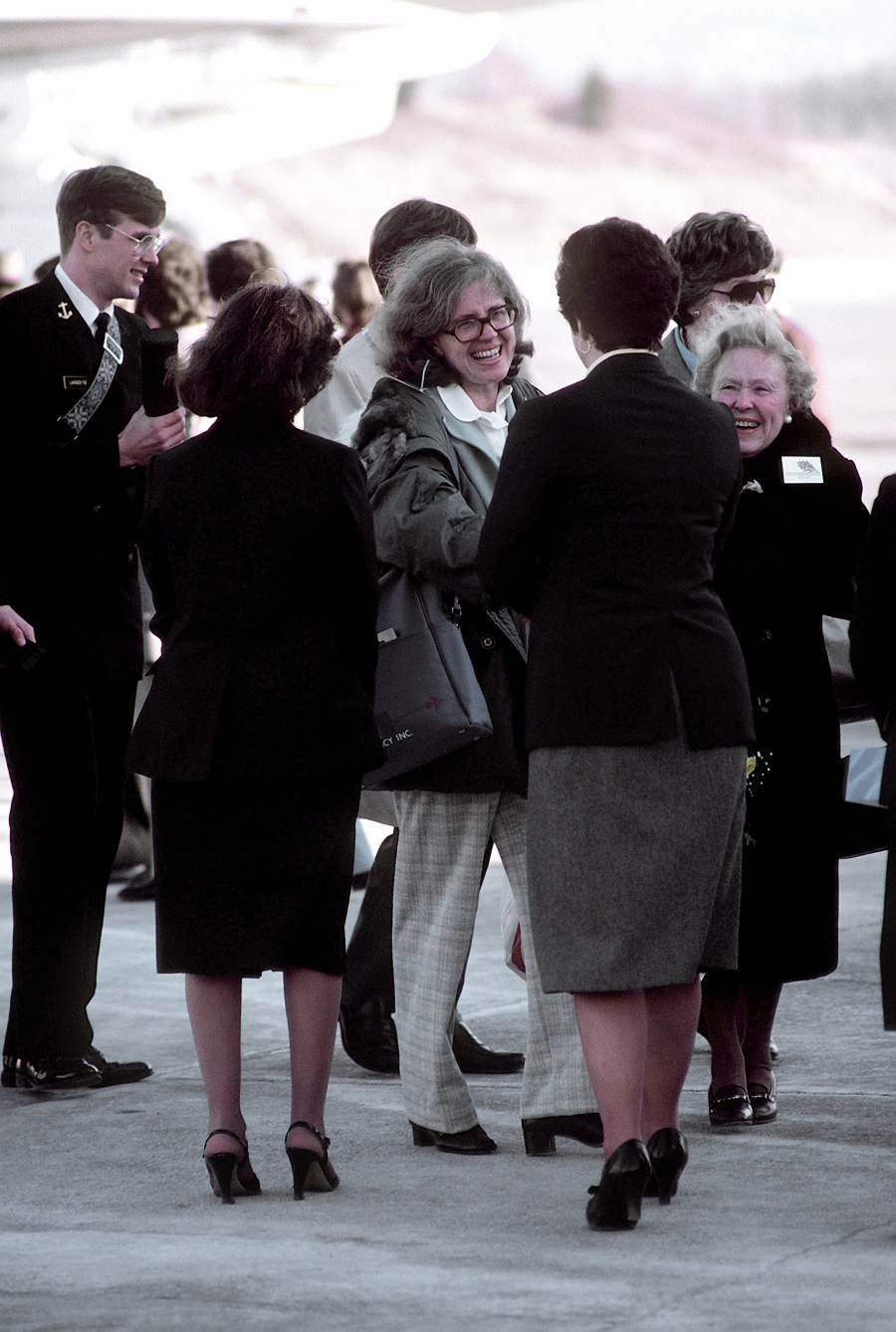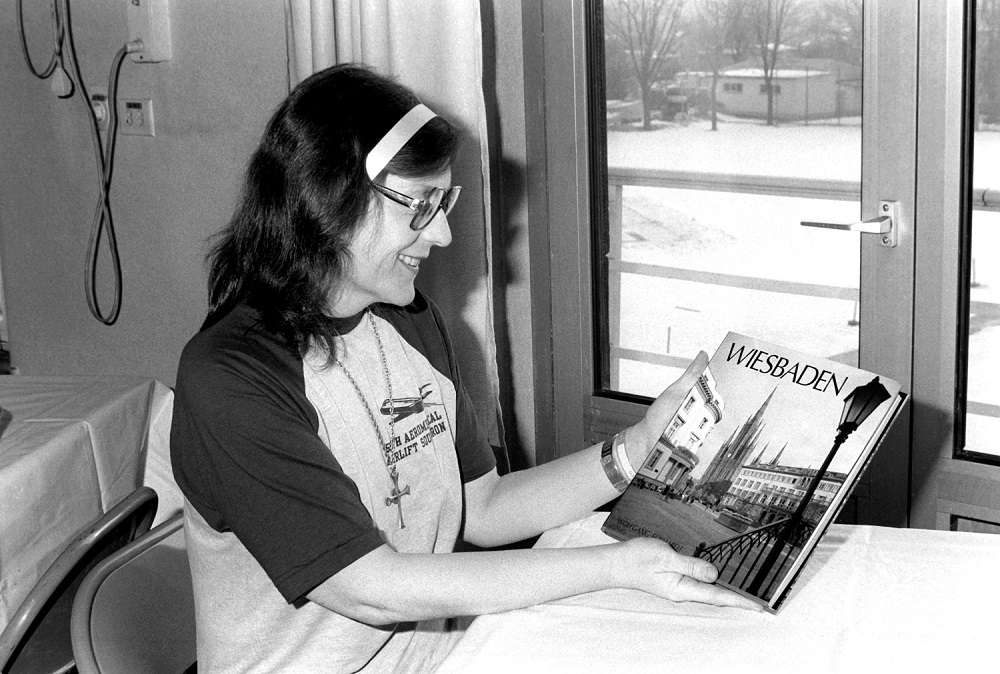Former hostages to Iran
Former hostages to Iran, Bruce Laingen (white coat), Kathryn Koob and Ann Swift, walk down the plane steps to touch the United States soil for the first time since their release, January 25, 1981. Department of Defense. American Forces Information Service. Defense Visual Information Center. (1994 – 10/26/2007)/National Archives.
Ann Swift
Former Iranian hostage, Ann Swift (wearing gray slacks) is greeted by her family as she arrives on U.S. soil for the first time since her release, January 25, 1981. Department of Defense. American Forces Information Service. Defense Visual Information Center. (1994 – 10/26/2007)/National Archives.
Kathryn Koob
Former hostage Kathryn Koob admires a book of sites of the city of Wiesbaden, a gift from Lord mayor Goerg-Berndt Oschatz. The 52 hostages are spending a few days in the hospital prior to their departure for the United States. January 1, 1981. Department of Defense. American Forces Information Service. Defense Visual Information Center. (1994 – 10/26/2007)/National Archives.
Background
During the Iranian Revolution of 1978–79, the Muslim leader Ayatollah Khomeini led the overthrow of the pro-Western leader, the Shah of Iran. After months of protests, the shah and his family fled the country, eventually making it to the United States. Revolutionaries declared Iran an Islamic Republic.
On November 4, 1979, a group of Iranian students entered the American embassy in Tehran, the capital of Iran. They were supporters of Khomeini and were angry with the American government for letting the shah receive medical treatment in the United States. They took 66 Americans hostage. Thirteen hostages, primarily women and Black men, were released on November 17. Khomeini believed that they were unlikely to be spies. They released another hostage the following July because he was severely ill. The revolutionaries held the remaining 52 hostages in captivity for 444 days.
About the Document
The images show two of the hostages, Kathryn Koob and Ann Swift, during the days following their release. They were the only two women among the 52 hostages who were held for the duration of the crisis. Kathryn was the head of the Iran-American Society in Tehran and a former officer of the United States International Communications Agency. Ann was the chief of the political division of the American embassy in Iran.
Kathryn and Ann were initially held with the other female hostages in one room, tied to chairs, and not allowed to talk or even look at each other. The other women were released after two weeks, and the hostage takers separated Kathryn and Ann. Scholars believe that they were not released with the other women in November 1980 because of their high-ranking positions. After living in their own rooms for four months, the hostage takers moved them in together. The Iranian students treated the women better than the male hostages, but it was an emotionally challenging situation. Kathryn and Ann believe that the years of discrimination they had faced as women in the workplace helped them stay strong mentally.
After months of negotiations, the hostages were finally released on January 20, 1981. They were first flown to West Germany, where they spent several days in a hospital for medical evaluation. Kathryn and Ann landed at Stewart Air National Guard Base, in Newburgh, New York, on January 25. Kathryn wore a white beret, which she had bought during a layover in Ireland.
Vocabulary
- diplomat: A person who officially represents their country in discussions with officials from other countries.
- embassy: A building where diplomats work in another country.
- hostage: A person who is captured by another person or group that demands something in exchange for keeping them alive.
- United States International Communications Agency (USICA): A U.S. government agency for public diplomacy. It existed between 1953 and 1999.
- Iran-American Society: An organization founded in Iran in the 1950s to promote understanding between Iranians and Americans.
- Islamic republic: A country whose government and laws are based on the religion of Islam.
- shah: The title of the former leader of Iran.
Discussion Questions
- What happened during the Iran Hostage Crisis?
- How can you describe the women in the photographs? How do you think they were feeling at that moment?
- What challenges did the women face during the crisis?
- Why do you think the Iranian hostage takers released most of the women and Black diplomats after a few weeks?
Suggested Activities
- Include this resource in a lesson about the Iran Hostage Crisis to consider the personal experiences of the two female hostages.
- Lead a close analysis of the photographs. What are the women doing? What are they feeling?
- Explore the impacts of U.S. foreign policy on women during this time period by combining this resource with the life stories of Maria Connie Villescas and Valentina Kozlova.
- For a larger lesson about the experiences of major historical events on women during this period, combine this resource with photographs of the Teacher in Space program, a speech about the effects of the nuclear disaster at Three Mile Island, the famous photograph of a young disability rights activist, Maxine Waters speaking on the Rodney King verdict, a collage by a 9/11 survivor, and the life stories of Maria Connie Villescas and Rachel Scott and Cassie Bernal.
Themes
AMERICA IN THE WORLD; POWER AND POLITICS









